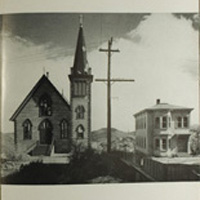The New American West
A Photographic Look
February 27–May 21, 2008

Wright Morris
Page from The Inhabitants
New York: Charles Scribner, 1946
The Clark Art Institute Library
The landscape of the American West has long been a subject for photographers. The advent of photography in the mid-nineteenth century and the development of easier methods of photographic reproduction corresponded with the western expansion of the nation. Photographic documentation augmented the reports issued as part of the United States Geological Survey of the Territories and photography was capturing the wondrous archaeological discoveries being made, as well as capturing the vestiges of American Indian culture. Civic boosters, hotel resorts, and railway lines were using photography in promotional material to woo visitors to the western states.
The post-World War II American West was a very different place. As the public claimed what was once open space for development, the wilderness that characterized the West became increasingly scarce and therefore more precious. Remaining wilderness areas, such as the National Parks, provided photographic inspiration for photographers beyond the mere documentary, ornamental, or promotional. Images of the West became, in addition, a vehicle for personal expression, whether it was the awe-inspiring grandeur revealed by Ansel Adams, the bittersweet nostalgia expressed by Wright Morris, or the ubiquitous, scarring hand of man found in the work of Robert Adams.
All of the works shown are from the Sterling and Francine Clark Art Institute Library.
 Wright Morris
Wright Morris
American, 1910–1998
The Inhabitants
New York: Charles Scribner’s Sons, 1946
The images in this work of photofiction are a visual commentary on the contemporary American West and what Morris called “the transient ruins of [his] own culture.” Architecture or other signs of man populate each photograph, yet all are devoid of the people that inhabit the landscape. Instead, the “inhabitants” appear on the facing page as elements in the accompanying fictional text. Morris’s aim was to capture the lifestyle and landscape he recalled from his youth in Nebraska and that he saw dissolving around him.

Ansel Adams
1902–1984
My Camera in the National Parks
Boston: Houghton Mifflin, 1950
Adams’s timeless photographs suggest the sublime grandeur of the American Western landscape. He was passionate about land conservation and a longtime board member of the Sierra Club, which utilized many of his images in their promotional and lobbying material. The present work, with its luminous images printed on Kromekote paper, is a visual paean to the National Parks system.
The Clark’s copy is signed by Ansel Adams.